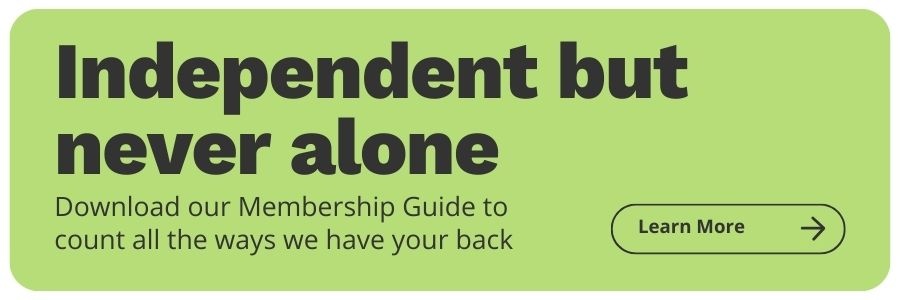When to Say No As an Advisor: Why a No Opens the Door to a Better Yes
Share this
We live in a “yes, and” society, where saying no is often accompanied by apologies and guilt. You may find yourself serving clients you aren’t crazy about, offering engagements you don’t enjoy, or perhaps even charging in a way you don’t want to. You won’t build a business you love if you let everyone “should” on you, so you need to learn how and when you get to say no.
Almost every planner I work with has gotten into this business to help people. Often, within the XYPN community, it is to help people traditionally left behind by the finance industry. Being in the minority of the industry leads to being “shoulded" upon” by other colleagues, and to having a very large pool of prospective clients who are not being served. You are so busy being told “no” by old-school planners and regulators that you can often hesitate to say no even when it will help you.
To build the business you want and serve people in a way that honors why you started your own RIA, you need to know when to say no. By saying no you can be saying yes to a healthier, happier business life. The better you get at saying no when appropriate, the more opportunities you will find to say yes.
Five Important Times to Say No
Let’s review five times when saying no is the best answer. There are more—don’t you worry. At the end of this blog, I hope you will see the opportunities you have to say no as well as “yes, and.”
When it comes to clients, you get to work with your best client. It’s ok to say no to people that are not a good fit. Planners often have fear or guilt around saying no to prospective clients—know that you can feel more confident in saying no. In addition to who you get to decide what you offer. You provide the engagements and style of planning that you enjoy. You can say no and support others in the industry as well as clients who want something other than what you offer. It’s a no that also gives a yes! No also comes into play with scheduling pitfalls. I will give you some tips to avoid them. If I had a nickel for every person who said you couldn’t run a business on fee-for-service I wouldn't be writing blogs for XY Planning Network anymore. Let’s dig into some scripting to explain how you charge and be comfortable saying no to other fee structures you may feel pressured to include. Another big “no” can be around growth. You create your own growth plan. I like to sum this up as #RideYourOwnRide and don’t let anyone else tell you what success is.
There are valid reasons to say no. By and large it will be to improve your efficiency and increase your joy. As we go through the five areas you'll see the pattern. The result of a well-timed no is being good and effective at what you do and being happy doing it.
You Get to Work With Your Best Client
It's not only ok to say no to people that are not a good fit, it’s good for you and for them.
By focusing on your ideal clients your expertise and energy stay focused. You go deep on content rather than work to cover every possible topic or question that you could address. You are not trying to be all things to all people. As you focus you naturally become more efficient because the needs of the families and individuals you serve overlap. Your knowledge, your content creation, every action you undertake will serve more people if your clients are similar. By focusing on the planning work you love and the type of clients you most enjoy you will find you bring more energy and joy to clients.
If you say no to the people reaching out to you how can that be good for them? They could end up anywhere. Or will they? I hope we can agree that everyone deserves a planner that is a good fit. I will posit that they deserve expertise that you may not have and they deserve a planner who enjoys the work they are doing. No one wants to frustrate you any more than you want to be frustrated. By saying no when appropriate you are acting in a fiduciary manner, even for people who aren’t paying clients. This gets to the core of who you are—you are making sure every client gets the best planner for their needs.
So how do you do it? Start by building your referral and resource list. You want to connect with fInancial coaches, financial therapists, and a host of other planners. Create a network of professionals you know and trust. By having planner colleagues with different styles, niches, and different expertise than yours, you can say no and yes at the same time. You never have to send someone off with no guidance on finding the best planner for them.
Use that referral list as you come upon people that are not an ideal fit for your firm. You can send them to a specific person based on their needs or send them to a list that would be a good fit. The more you know and like them the more likely you are to send to a specific referral. If they could go with a lot of others, just not you for whatever reason, send them to xyplanningnetwork.com or perhaps NAPFA.org. If you find yourself with a fee mismatch you can send them to a planner that uses that fee structure or give them tips on how to search more specifically on an advisor search site. There will be times when you get a bad vibe. Do not assume a bad vibe for you is going to be bad for everyone. Everyone can find someone who clicks for them.
Create email templates to help you do this more efficiently. If you are on a call or in person, it’s as simple as this:
I am so honored that you reached out and I am very happy to see you starting on a financial planning journey. I don’t believe you would be best served by our firm because you need ______________. I suggest you look for a planner at _______. Some key phrases you want to look for are ___________. It’s important to work with a planner who works well with your style and fully understands the nuances of your situation.
A couple of specific examples you may run into are:
I don’t believe you would be best served by our firm because you are interested in hourly work and our firm does exclusively ongoing financial planning. I suggest you look for a planner at XY Planning Network or Garrett Planning Network. Some key phrases you want to look for are hourly or project.
I don’t believe you would be best served by our firm because you have complex tax issues. I suggest you look for a planner at XY Planning Network, AICPA, or ACP. Some key phrases you want to look for are tax planning as well as planners with a CPA or EA in addition to their CFP.
I don’t believe you would be best served by our firm because you have complex rental real estate issues. I suggest you look for a planner at XY Planning Network. A key phrase you want to look for is real estate.
I don’t believe you would be best served by our firm because at your current stage you would benefit more from financial coaching to set a good foundation before you proceed to full financial planning. I suggest you look for a planner at XY Planning Network or AFCPE. A key phrase you want to look for is financial coaching, people with an Accredited Financial Counselor or Financial Fitness Coach designation.
What You Do and Offer Is up to You
When it comes to engagements you offer you can say yes and no as you wish. This builds off of the ideal client concept above but focuses on what you are doing throughout the year for your clients. Once again you can support others in the industry as well as clients who want something other than what you offer at the same time.
Some examples of focusing on engagements you want are not only the hourly and project work mentioned but also investments-only relationships or your decision on whether or not to provide one-time plans. You may wish to create and deliver plans in a modular way that aligns with your subscription fee model. If you want to do life planning with every client, just let them know upfront what to expect and say no to folks not interested in that style of planning. You let everyone know, loud and proud, that you offer what you offer. That’s it in a nutshell.
If ever you find yourself dreading client work, you need to take the time to look into why you are dreading it. Be willing to sit with it and make the changes to rid yourself of that dread. You have the ability to do all sorts of engagements. But just because you can doesn’t mean you should, and it definitely does mean that you have to. Keep that in mind as you look at “no” for the engagement area. I find planners struggle here a bit because “not my expertise” from our items above is easier than seeing that you can say “because I don’t want to.” It is perhaps harder, but that does not make it less valid.
You are going to script this pretty much the same way as you did above, but you have to dig into your belief that you are worth it. You need to remind yourself that you deserve to work within the parameters you choose! Use the resources you lined up above and create email templates for this as well if you wish.
The script is similar and you don’t need to make it complicated. You just need to be strong in your belief that you are fine saying no.
I am so honored that you reached out and I am very happy to see you starting on a financial planning journey. I don’t believe you would be best served by our firm because you are interested in a short-term engagement and we truly enjoy and believe in the value of an ongoing planning relationship. I suggest you look for a planner at XY Planning Network. Some key phrases you want to look for are one-time plans or projects. It’s important to work with a planner who works well with your style and fully understands the nuances of your situation.
This is a great chance to use specific planner referrals. You may have really hit it off with this person, you just want to be true to the engagement style you most enjoy. Send them to someone who enjoys working in the manner this person is looking for.
You Are Not the Cheesecake Factory
I will warn you right now that how you charge can bring out the haters. As you proceed, remember you don't have to explain yourself to the rest of the planners in the world. Your fees are between you, the people you serve, and of course, your regulators. Don’t try to offer every fee structure just to please “the industry.” The reason you say no here is more of the same: you gain efficiency and happiness. Boom—that’s it. See a theme? Some folks think the happiness claim is a stretch, but being true to yourself and what you believe is fair and appropriate for the people you want to serve will make you happier.
There’s even a business development win for this “no.” People get confused if you slap a Cheesecake Factory menu out there for your fees. You want them to see what they will get, what they will pay, and why it is valuable. You do not have to be all things to all people. The reality is that the more choices we give, the more likely people are to get overloaded and make no choice. Keep it simple so people easily understand what they want to sign up for.
You don’t need to defend how you choose to price. There are reasons for all the fee-only and fee-for-service structures, but that doesn’t mean they are all for you. Stay above the fray and #RideYourOwnRide.
There’s really no new scripting here when you are working with clients or prospective clients. Use your website to show what you offer and unapologetically explain how you determined it was best for your clients.
“I determined that by charging a monthly planning fee I would be able to reach people who did not have a lot of assets outside of their 401(k) but were still in need of planning support.”
When Do You Work? Boundary Setting 101
There are a couple of versions of “when” no’s. It can refer to when during the week or day that you’ll work as well as when you’ll begin working with a client. We’ll address them both, but it all circles back to the fact that you get to say no whenever you don’t want to work. You need to do this to protect your homelife and non-client business time.
Since you are serving yourself rather than clients with this “no,” it can be a bit harder to convince yourself it’s alright. Use tools and habits to help you out. The more you take away your chance to make exceptions the better. You’ll be more efficient, happier, and less prone to the entrepreneurial exhaustion that can befall the new business owner.
Let’s begin with your work schedule. During the week you create your own hours. You can work banker’s hours, but even then you need to look at some good-sized blocks of time for the business, non-client time for admin, creation, strategic thinking, etc. So I suggest you limit yourself to three days a week (four max) where you have meetings.
You may want non-traditional hours. I just worked with an XYPN member whose partner was shifting to the night shift for a while, so they shifted to later in the day, noon to 7:00 PM, so that they could have time together when he got home from work. When you choose your hours you do not owe anyone an explanation. You let clients know, update your website and that’s that. In this instance, you may want to share why and even note that you believe in modeling a life/work balance for the people you serve. But you can also say, “I have decided to shift hours for a bit of variety, so until Labor Day I will be working from 8–6 Tuesday through Thursday so that I can enjoy more time with my family during the summer months. “ The reasons for non-traditional hours are as varied as the number of planners, but the bottom line is that you get to choose.
As you create your work schedule, consider your energy levels. Do you kind of suck at 8AM meetings? Don’t have them. Hitting the wall by 4? Don’t schedule meetings. Don’t try to tell me you “have to” for your clients. People take time to see CPAs, attorneys, doctors, and all manner of other professionals during regular business hours. They can prioritize you, too. That said, if you are a night person or like to meet on weekends, go for it. Just do things from a place of intentionality, not fear.
As you limit your options you will soon find that people interested in working with you have to wait a bit. That’s ok. They will survive and you will have meetings with people who are very committed to the process because they waited for you. Let me be clear, this does not apply to existing clients. You want them to meet you in a timely manner based on your own client scheduling practices.
I find planners struggle to control their own pipeline flow. The more you can have a script in the back of your mind, the easier it is to stay strong in your boundaries. By using a scheduling tool (Calendly, Acuity, or the like) you have the tool telling you when you are available. Limit the number of each type of appointment you offer. You can send it so the person inquiring can schedule at their convenience or you can use it yourself as you help them schedule. But keep in mind that you aren’t looking at the calendar yourself thinking “Well, if I push that over there and cut down my writing time this week I can fit one more meeting in and they sound so interested.” Instead, you just look at what Calendly tells you is open. Like this:
I would love to schedule a time to chat more about your needs. My next get-acquainted chat is available on _____________ .
Allow your scheduling software to help you be strong. They will live and they will wait. There is a “yes” that comes from every “no.” The yes here is better life/work balance, more efficiency, and higher-quality work. The clients who play by your rules are already showing respect for you and that they value you as a professional. That is a great yes!
No to Growth (Are You Sure, Arlene?)
The final no we are touching on is “no to growth.” You create your own growth plan because you know your own life—it’s as simple as that. You grow as you need or wish not to. There’s no absolute on how fast or how slow you grow. I have heard it all, from one client a year to a dozen in a month. Let’s dig into some considerations so you understand what you are hearing the next time you feel you aren’t growing like you “should.”
Some elements that impact your onboarding rate and growth are the amount of work you do upfront versus in your ongoing relationship. You also need to acknowledge what else is in your life. Do you have another Job? Are you a caregiver for your kids? Are you working on an advanced degree? There are only so many work hours available. Build your realistic growth goals based on the reality of your life. You want every client to have the best possible experience. As you grow you will discover the efficiencies you need to develop, but let yourself grow at a pace that allows you to create those processes as you move forward.
Don’t drown yourself and don’t do a disservice to those clients. Take the time you need to provide them with a high-quality experience. That will pay dividends down the road in referrals and retention. Don’t compare apples to oranges as you look around the planning industry. If you are doing a lot of upfront work, you can’t onboard as many clients as a firm that provides modular planning over the course of a year. If a firm has group coaching or online courses with a low-touch level of service for clients, they can onboard significantly more clients than a more traditional firm.
This “no” is piggybacking off of the above scheduling no’s. You onboard new clients at a pace that makes sense for you and your firm. The scripting is very simple:
I am so excited to hear you have decided to move forward. I will send you a few items as we get started. My next welcome-aboard meeting is on _____________________.
These are just five of the times you may need to say no. I am sure there will be others, but if I can get you to embrace these five and #RideYourOwnRide, that’s a great start. Usually, you will find me firmly in the “yes, and” camp, but sometimes saying no is required to say yes to something else. Get started today by deciding what “no” you need to make room for an amazing “YES!”

About the Author
Arlene Moss, XYPN's Executive Business Coach, gets a kick out of helping financial advisors get over being overwhelmed and take on their frustrations so their businesses soar. Arlene works to ensure XYPN members are able to help their clients prosper while creating a sustainable business model. Through XYPN Academy and one-on-one coaching, members get the support they need to grow their businesses and overcome the challenges that come their way.
Share this
- Fee-only advisor (381)
- Advice (305)
- Business Development (248)
- Independent Financial Advisor (203)
- Growing Your Firm (161)
- Marketing (133)
- Financial Planning (129)
- What Would Arlene Say (WWAS) (81)
- Business Coach (80)
- Firm Ownership (78)
- Training (75)
- Compliance (72)
- Business (69)
- Building Your Firm (65)
- Financial Advisors (63)
- Online Marketing (61)
- Events (59)
- Starting a Firm (52)
- Staffing & HR (49)
- Technology (49)
- From XYPN Members (48)
- Launching a firm (46)
- Advisors (41)
- Entrepreneurship (38)
- Taxes (37)
- Networking & Community (33)
- Interviews and Case Studies (32)
- Investment Management (31)
- Sales (27)
- Social Responsibility (27)
- Tax Preparation (27)
- XYPN Invest (26)
- Business Owner (25)
- Small Business Owner (20)
- Financial Management & Investment (19)
- Industry Trends & Insights (19)
- Financial Education (17)
- Financial Planners (17)
- Independent Financial Planner (17)
- Tech Stack (17)
- XYPN (17)
- Leadership & Vision (16)
- Investing (15)
- Niche (15)
- How to be a Financial Advisor (14)
- NextGen (14)
- RIA (14)
- Media (13)
- Preparing to Launch (13)
- Press Mentions (13)
- RIA Operations (12)
- RIA Owner (12)
- XYPN Membership (12)
- Assets Under Management (AUM) (11)
- First Year (11)
- Goals (11)
- Scaling (10)
- Advisor Success (9)
- Building Your Firm (8)
- Communication (8)
- Lessons (8)
- Study Group (8)
- Time Management (8)
- Virtual Advisor (8)
- Behavioral Finance (7)
- Growth (7)
- Pricing Models (7)
- From Our Advisors (6)
- Independent RIA (6)
- Money Management (6)
- Motivation (6)
- Processes (6)
- Automation (5)
- Broker-Dealers (5)
- College Planning (5)
- Filing Status (5)
- How I Did It series (5)
- Investment Planner (5)
- Mental Health (5)
- Michael Kitces (5)
- Preparing to Launch (5)
- RIA Operations (5)
- Retirement (5)
- Risk and Investing (5)
- S Corpration (5)
- Support System (5)
- TAMP (5)
- Wealth (5)
- Year-End (5)
- Client Services (4)
- Outsourcing (4)
- Selling a Firm (4)
- Succession Plans (4)
- Benchmarking Study (3)
- Budgeting (3)
- Career Changers (3)
- Engagement (3)
- Fiduciary (3)
- Getting Leads (3)
- Membership (3)
- Millennials (3)
- Monthly Retainer Model (3)
- Partnership (3)
- Pricing (3)
- Recordkeeping (3)
- Risk Assessment (3)
- Small Business (3)
- Staying Relevant (3)
- Work Life Balance (3)
- Advice-Only Planning (2)
- Bookkeeping (2)
- Charitable Donations (2)
- Client Acquisition (2)
- Differentiation (2)
- Health Care (2)
- IRA (2)
- Inflation (2)
- Productivity (2)
- Implementing (1)
Subscribe by email
You May Also Like
These Related Stories

How to Determine Your Pricing and Services as You Launch Your Firm

How the Entrepreneurial Operating System (EOS) Can Make Your Firm Thrive





